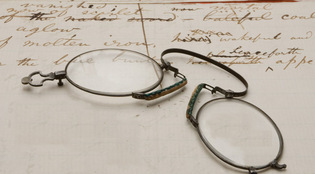 loading
loading
featuresA self-invented manThe many meanings of Walt Whitman's glasses Michael Cunningham has published four novels, including the Pulitzer Prize–winning The Hours. He teaches fiction writing at Yale.  Mark MorosseWhitman's last pair of eyeglasses, shown here on a manuscript draft of "Rise, Lurid Stars," which Whitman composed in about 1865 but never published in full. View full imageIf we harbored any collective doubts about whether an object can be too rich and significant to write about, the matter of Walt Whitman’s glasses should put those doubts to rest. I mean, really. Walt Whitman’s glasses. Like Emily Dickinson’s bed or Herman Melville’s customs office uniform, this particular pair of spectacles resides in that peculiar realm of metaphor so potent as to exist already, fully formed, in all our minds. Nobody who’s read even a little of Whitman needs me to get poetic about What Those Eyes Beheld, or about the nervous system that connected soul to brain to eyes to lenses to nineteenth-century America and which was, ultimately, able to reach back from beyond mortality itself and speak to us, the still-living, about the constant intercession of the past into the present. See, I’m already going misty on you. I’d rather talk briefly about what the glasses (artificial enhancers that they are) imply about Whitman as a self-invented man. Not as a self-created man—American history is irritatingly full of such people—but as, arguably, the first American artist not only to generate a body of great work but to enhance himself into—invent himself as, if you will—someone who could credibly produce the work in the first place. The young (and the no-longer-all-that-young) Whitman was a dreamer and a dilettante, prone to half-hearted performances as a teacher and a journalist, among other occupations. He wrote (strictly for money, as he’d later claim) a negligible novel about temperance. It was not until he’d reached his late 30s that this drifty slacker produced, out of nowhere (biographically speaking), Leaves of Grass. He would spend the subsequent 35 years expanding and revising and re-re-republishing it, a total of seven times. Literature offers us the occasional late bloomer—old Joe Conrad, having published his first novel at the age of 38, is a particular favorite of unheralded writers who begin feeling like failures in their mid-20s—but for the most part genius tends to manifest itself well before the genius in question comes to the attention of the AARP. Rimbaud had stopped writing poetry entirely almost two decades before the age at which Whitman got started, and Keats died ten years younger. By Whitman’s debut age, Flannery O’Connor had pretty much produced her entire body of work, and Chekhov would have only seven more years in which to write. Who cares? No one, certainly not about a few years more or less where works of immortal brilliance are concerned. Whitman, however, is a case unto himself. It seems to have taken him the better part of his first four decades not only to conceive and write the first edition of Leaves of Grass, but also to transform himself from a callow drifter into the visionary, ecstatic bard we revere. And, okay, maybe . . . the bard he could revere as well. I suspect he had to feel like a poet in order to function as one. He became a performer in a costume, to miraculous effect. He is part of a fabulous, distinctly American line of figures who essentially pictured someone larger and grander than themselves and then, by force of will combined with a few judicious borrowings and calculations, became that person. Feckless Walt became Walt Whitman the Poet as, some time later, Cassius Clay will become Muhammad Ali and Robert Zimmerman will become Bob Dylan. The eyeglasses, by the way, are real, but it doesn’t seem impossible for Whitman to have decided that Walt Whitman, capital W capital W, would wear glasses, just as surely as he’d wear workingman’s clothes, a beard, and a big slouchy hat. An item of Whitman’s apparel, then, is especially marvelous, and for gratifyingly human reasons. None of it was in any way arbitrary or accidental. Whitman dressed himself as Whitman, a notion at odds with the way we tend to prefer our departed poets, who are generally supposed, when alive, to have been either wholly indifferent to the physical world or at the very least eager to transcend it, and who maintained a healthy skepticism about its apparent heft and density. Whitman exulted in the world’s heft and density. He was among the least lily-livered poets who’ve ever lived. He adored the world, and insisted on the simultaneous realness and divinity of its every locale and denizen, from the refined to the destitute to the despicable. He was an ordinary Joe who turned himself into a seer, and although it seems safe to say that genius can’t be summoned out of nowhere, we’ll never know how much or how little it mattered to Whitman—what fundamental confidence he may have released within himself—by starting to look and act—there’s no other way to say it—like a poet. That’s what’s so wonderful about being in the presence of Whitman’s spectacles. They’re not symbols; anyway they’re not merely symbols. Nor are they the material leavings of a saint, with all a relic implies about the gulf between spirit and flesh. This fragile pair of eyeglasses suggests the exact opposite—that the gulf between spirit and flesh is overrated, and that we can, in theory anyway, put on the glasses and, in so doing, call up some nascent inner being to become the man behind the glasses. It’s difficult to imagine a more resonant but humble object.
The comment period has expired.
|
|